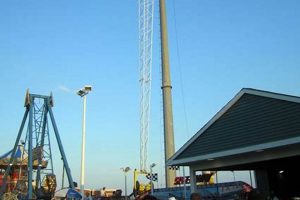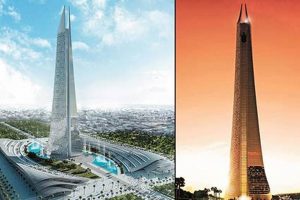A skyscraper is a continuously habitable high-rise building that has over 40 floors and is taller than 150 meters (492 feet). Skyscrapers are often used for commercial purposes, such as offices, retail stores, and hotels, but can also be used for residential purposes.
Skyscrapers are important because they can house a large number of people and businesses in a relatively small area. This can help to reduce traffic congestion and pollution, and can also make it easier for people to live and work in close proximity to each other. Additionally, skyscrapers can be iconic landmarks that define a city’s skyline.
The first skyscraper was built in Chicago in 1885. Since then, skyscrapers have been built in cities all over the world. Some of the most famous skyscrapers include the Empire State Building in New York City, the Petronas Towers in Kuala Lumpur, and the Burj Khalifa in Dubai.
1. Tall
One defining characteristic of a skyscraper is its height. Skyscrapers are typically much taller than other buildings, with some reaching over 1,000 feet tall. This height gives skyscrapers their iconic status and makes them landmarks in many cities. However, building tall structures also comes with a number of challenges.
One challenge is structural stability. Tall buildings are more susceptible to wind and seismic forces than shorter buildings. To ensure stability, skyscrapers must be designed with strong foundations and reinforced structures. Another challenge is fire safety. In the event of a fire, it can be difficult to evacuate people from a tall building, and firefighters may have difficulty reaching the upper floors. To address this, skyscrapers are equipped with fire safety systems such as sprinklers, fire alarms, and emergency stairs.
Despite these challenges, the benefits of building tall outweigh the risks. Skyscrapers can house a large number of people and businesses in a relatively small area. This can help to reduce traffic congestion and pollution, and can also make it easier for people to live and work in close proximity to each other. Additionally, skyscrapers can be iconic landmarks that define a city’s skyline.
Some of the tallest skyscrapers in the world include the Burj Khalifa in Dubai, the Shanghai Tower in China, and the One World Trade Center in New York City. These buildings are marvels of engineering and construction, and they continue to push the boundaries of what is possible in architecture.
2. Dense
Skyscrapers are often built in dense urban areas, where land is scarce and expensive. This is because skyscrapers can house a large number of people and businesses in a relatively small area. This can help to reduce traffic congestion and pollution, and can also make it easier for people to live and work in close proximity to each other.
- Population Density
Skyscrapers can accommodate a large number of people in a small area. This is because they are built vertically, with multiple floors stacked on top of each other. This allows skyscrapers to house a much greater number of people than a single-story building with the same footprint.
- Business Density
Skyscrapers can also accommodate a large number of businesses in a small area. This is because they can provide a variety of spaces, from small offices to large corporate headquarters. This allows businesses to locate their employees in close proximity to each other, which can improve communication and collaboration.
- Mixed-Use Development
Skyscrapers are often mixed-use developments, which means that they include a variety of uses, such as residential, commercial, and retail. This can help to create a more vibrant and sustainable urban environment.
- Transportation Hubs
Skyscrapers are often located near transportation hubs, such as train stations and bus stops. This makes it easy for people to get to and from work, and can also reduce traffic congestion.
The density of skyscrapers can have a number of benefits, including:
- Reduced traffic congestion
- Reduced pollution
- Increased convenience
- Improved communication and collaboration
- More vibrant and sustainable urban environments
However, the density of skyscrapers can also have some challenges, such as:
- Increased construction costs
- Increased energy consumption
- Increased noise pollution
- Increased wind speeds
- Increased fire risk
Overall, the benefits of skyscraper density outweigh the challenges. Skyscrapers can help to create more livable, sustainable, and vibrant cities.
3. Urban
Skyscrapers are almost exclusively an urban phenomenon. They are built in cities, and they are designed to serve the needs of urban populations. There are a number of reasons for this:
- Land scarcity: Land is scarce in cities, and skyscrapers allow developers to build up instead of out. This can be especially important in densely populated cities, where there is little room for new development.
- Transportation: Skyscrapers are often located near transportation hubs, such as train stations and bus stops. This makes it easy for people to get to and from work, and can also reduce traffic congestion.
- Business needs: Businesses often need to be located in close proximity to each other in order to collaborate and compete. Skyscrapers can provide businesses with the space they need to do this, while also allowing them to be close to their customers and suppliers.
- Cultural amenities: Cities offer a wide range of cultural amenities, such as museums, theaters, and restaurants. Skyscrapers can provide residents with easy access to these amenities, which can improve their quality of life.
Skyscrapers have a number of benefits for urban areas. They can help to reduce traffic congestion, pollution, and noise. They can also make cities more livable and sustainable. However, skyscrapers can also have some negative impacts, such as increased construction costs, energy consumption, and wind speeds. Overall, the benefits of skyscrapers outweigh the challenges, and they continue to be an important part of the urban landscape.
Here are some examples of how skyscrapers are used in urban areas:
- Office buildings: Skyscrapers are often used for office space. This is because they can provide businesses with a large amount of space in a convenient location.
- Residential buildings: Skyscrapers are also used for residential purposes. This is because they can provide residents with a variety of amenities, such as, swimming pools, and doormen.
- Mixed-use buildings: Skyscrapers are often
mixed-use developments, which means that they include a variety of uses, such as residential, commercial, and retail. This can help to create a more vibrant and sustainable urban environment.
Skyscrapers are an important part of the urban landscape. They provide a number of benefits for urban areas, and they continue to be built in cities all over the world.
4. Iconic
Skyscrapers are often iconic landmarks that define a city’s skyline. This is because they are tall, impressive structures that can be seen from miles around. Skyscrapers can also be iconic because of their unique design or architecture. For example, the Empire State Building in New York City is instantly recognizable because of its Art Deco design. The Petronas Towers in Kuala Lumpur are iconic because of their twin towers and skybridge.
There are a number of reasons why skyscrapers are so often iconic. First, they are a symbol of power and wealth. Skyscrapers are often built by major corporations or governments, and they can be seen as a statement of the city’s economic and political power. Second, skyscrapers are often used for important purposes, such as housing businesses, offices, and residential units. This makes them a central part of the city’s daily life and culture.
The iconic status of skyscrapers can have a number of benefits for a city. First, it can attract tourists and visitors. People from all over the world come to see iconic skyscrapers, such as the Eiffel Tower in Paris or the Burj Khalifa in Dubai. This can boost the city’s economy and create jobs. Second, iconic skyscrapers can help to create a sense of place and identity for a city. They can be a source of pride for residents and a symbol of the city’s unique character.
However, the iconic status of skyscrapers can also come with some challenges. For example, iconic skyscrapers can be expensive to build and maintain. They can also be a target for terrorist attacks or other disasters. Additionally, the iconic status of skyscrapers can lead to gentrification and displacement of low-income residents.
Overall, the iconic status of skyscrapers is a complex issue with both benefits and challenges. However, there is no doubt that skyscrapers are some of the most recognizable and important buildings in the world. They are a symbol of human ingenuity and ambition, and they continue to play an important role in the development of our cities.
5. Functional
Skyscrapers are not just iconic landmarks; they are also functional buildings that serve a variety of purposes. Skyscrapers are used for office space, residential units, retail stores, and hotels. They can also be used for mixed-use developments, which include a combination of these uses. This makes skyscrapers a versatile and efficient way to use land in dense urban areas.
One of the most important functional aspects of skyscrapers is their ability to accommodate a large number of people in a relatively small area. This is especially important in cities where land is scarce and expensive. Skyscrapers can also be designed to be energy-efficient and sustainable, which can help to reduce their environmental impact.
Here are some examples of how skyscrapers are used functionally:
- Office buildings: Skyscrapers are often used for office space because they can provide businesses with a large amount of space in a convenient location. This can help businesses to attract and retain top talent, and it can also improve communication and collaboration between employees.
- Residential buildings: Skyscrapers are also used for residential purposes. This is because they can provide residents with a variety of amenities, such as swimming pools, fitness centers, and doormen. Skyscrapers can also be a good option for people who want to live in a walkable neighborhood with easy access to public transportation.
- Mixed-use developments: Skyscrapers are often mixed-use developments, which means that they include a variety of uses, such as residential, commercial, and retail. This can help to create a more vibrant and sustainable urban environment. For example, a mixed-use skyscraper could include a grocery store, a gym, and a movie theater on the lower floors, with office space and residential units on the upper floors.
Skyscrapers are an important part of the urban landscape. They provide a variety of functional benefits, and they can help to create more livable and sustainable cities.
6. Sustainable
Skyscrapers are often seen as symbols of progress and innovation, but they can also be a major source of environmental pollution. However, there is a growing movement towards sustainable skyscraper design, which seeks to reduce the environmental impact of these buildings.
- Energy Efficiency
One of the most important aspects of sustainable skyscraper design is energy efficiency. Skyscrapers can consume a lot of energy, but there are a number of ways to reduce energy consumption, such as using energy-efficient lighting, appliances, and HVAC systems. Additionally, skyscrapers can be designed to take advantage of natural light and ventilation, which can also help to reduce energy consumption.
- Water Conservation
Skyscrapers can also consume a lot of water. However, there are a number of ways to conserve water in skyscrapers, such as using low-flow fixtures and rainwater harvesting systems. Additionally, skyscrapers can be designed to capture and reuse stormwater, which can also help to reduce water consumption.
- Waste Reduction
Skyscrapers can also produce a lot of waste. However, there are a number of ways to reduce waste in skyscrapers, such as recycling and composting programs. Additionally, skyscrapers can be designed to use sustainable materials, which can also help to reduce waste.
- Indoor Environmental Quality
The indoor environmental quality of skyscrapers is also important. Skyscrapers can be designed to provide occupants with a healthy and comfortable indoor environment, by using natural materials, providing access to natural light and ventilation, and controlling indoor air quality.
Sustainable skyscraper design is a complex challenge, but it is an important one. By designing skyscrapers that are more energy-efficient, water-conserving, and waste-reducing, we can help to reduce the environmental impact of these buildings and create a more sustainable future.
7. Expensive
Skyscrapers are expensive to build and maintain. This is due to a number of factors, including the cost of land, the cost of materials, and the cost of labor. Additionally, skyscrapers are often designed with complex and innovative features, which can also add to the cost.
- Land
Land is scarce in urban areas, and this drives up the cost of land for skyscraper development. In some cases, the cost of land can account for more than half of the total cost of a sky
scraper. - Materials
Skyscrapers are built using a variety of materials, including steel, concrete, and glass. These materials can be expensive, especially when they are used in large quantities.
- Labor
Skyscrapers are complex structures to build, and this requires a skilled workforce. Labor costs can account for a significant portion of the total cost of a skyscraper.
- Features
Skyscrapers are often designed with complex and innovative features, such as sky gardens, swimming pools, and fitness centers. These features can add to the cost of a skyscraper.
The high cost of skyscrapers can have a number of implications. First, it can make it difficult for developers to finance skyscraper projects. Second, it can lead to higher rents and purchase prices for skyscraper units. Third, it can make it difficult for cities to afford to build and maintain public infrastructure around skyscrapers.
Despite the high cost, skyscrapers continue to be built in cities around the world. This is because skyscrapers can provide a number of benefits, such as increased density, improved energy efficiency, and iconic status. However, it is important to be aware of the costs associated with skyscrapers before undertaking any development project.
FAQs about Skyscrapers
Skyscrapers are tall, continuously habitable buildings that have over 40 floors and are taller than 150 meters (492 feet). They are often used for commercial purposes, such as offices, retail stores, and hotels, but can also be used for residential purposes.
Here are some frequently asked questions about skyscrapers:
Question 1: What is the tallest skyscraper in the world?
The tallest skyscraper in the world is the Burj Khalifa in Dubai, United Arab Emirates. It is 828 meters (2,717 feet) tall and has 163 floors.
Question 2: What is the first skyscraper in the world?
The first skyscraper in the world is the Home Insurance Building in Chicago, United States. It was built in 1885 and is 42 meters (138 feet) tall with 10 floors.
Question 3: Are skyscrapers safe?
Skyscrapers are designed to be safe and withstand high winds and earthquakes. They are built with strong foundations and reinforced structures. However, no building is completely safe from natural disasters.
Question 4: Are skyscrapers energy efficient?
Skyscrapers can be energy efficient if they are designed with energy-efficient features, such as energy-efficient lighting, appliances, and HVAC systems. Additionally, skyscrapers can be designed to take advantage of natural light and ventilation, which can also help to reduce energy consumption.
Question 5: Are skyscrapers sustainable?
Skyscrapers can be sustainable if they are designed with sustainable features, such as water-saving fixtures, rainwater harvesting systems, and waste reduction programs. Additionally, skyscrapers can be designed to use sustainable materials, which can also help to reduce their environmental impact.
Question 6: Why are skyscrapers built?
Skyscrapers are built for a variety of reasons, including:
- To house a large number of people and businesses in a relatively small area
- To reduce traffic congestion and pollution
- To create iconic landmarks
- To take advantage of views and natural light
Skyscrapers are a complex and fascinating building type. They are a testament to human ingenuity and ambition, and they continue to play an important role in the development of our cities.
Tips for Designing Skyscrapers
Skyscrapers are complex and challenging structures to design. However, there are a number of tips that can help architects and engineers to create skyscrapers that are safe, sustainable, and iconic.
Tip 1: Consider the context
When designing a skyscraper, it is important to consider the context in which it will be built. This includes the surrounding buildings, the climate, and the local culture. For example, a skyscraper in a dense urban area will need to be designed differently than a skyscraper in a rural area.
Tip 2: Use sustainable materials and construction methods
Skyscrapers can be a major source of environmental pollution. However, there are a number of ways to reduce the environmental impact of skyscrapers, such as using sustainable materials and construction methods.
Tip 3: Design for energy efficiency
Skyscrapers can consume a lot of energy. However, there are a number of ways to design skyscrapers to be more energy efficient, such as using energy-efficient lighting, appliances, and HVAC systems.
Tip 4: Create a safe and comfortable indoor environment
The indoor environment of a skyscraper is important for the health and well-being of its occupants. Architects and engineers should design skyscrapers to create a safe and comfortable indoor environment, by using natural materials, providing access to natural light and ventilation, and controlling indoor air quality.
Tip 5: Design for flexibility and adaptability
Skyscrapers should be designed to be flexible and adaptable, so that they can be used for a variety of purposes and can be easily adapted to changing needs. For example, a skyscraper could be designed with a flexible floor plan that can be easily reconfigured to accommodate different types of businesses.
Tip 6: Consider the views
Skyscrapers offer unique views of the surrounding city. Architects and engineers should design skyscrapers to take advantage of these views, by providing occupants with access to balconies, terraces, and other outdoor spaces.
Tip 7: Create a sense of place
Skyscrapers can be more than just tall buildings. They can also be places where people live, work, and play. Architects and engineers should design skyscrapers to create a sense of place, by providing a variety of amenities and public spaces.
Tip 8: Design for the future
Skyscrapers are long-term investments. Architects and engineers should design skyscrapers to be durable and sustainable, so that they can continue to be used for generations to come.
By following these tips, architects and engineers can create skyscrapers that are safe, sustainable, iconic, and enjoyable places to live, work, and play.
Summary of key takeaways or benefits
- Skyscrapers can be designed to be safe, sustainable, and iconic.
- By following these tips, architects and engineers can create skyscrapers that are a valuable addition to the urban environment.
Transition to the article’s conclusion
Skyscrapers are a complex and challenging building type, but they can also be a beautiful and inspiring part of the urban landscape. By following these tips, architects and engineers can create skyscrapers that are not only tall and impressive, but also safe, sustainable, and enjoyable places to live, work, and play.
Conclusion
Skyscrapers are tall, continuously habitable buildings that have over 40 floors and are taller than 150 meters (492 feet). They are often used for commercial purposes, such as offices, retail stores, and hotels, but can also be used for residential purposes. Skyscrapers are a complex and challenging building type, but they can also be a beautiful and inspiring part of the urban landscape.
In this article, we have explored the history, design, construction, and sustainability of skyscrapers. We have also discussed the benefits and challenges of building skyscrapers, and we have provided tips for designing skyscrapers that are safe, sustainab
le, and iconic.
Skyscrapers are a testament to human ingenuity and ambition. They are a symbol of our ability to build tall and impressive structures, and they are a reminder of the importance of sustainability and livability in our cities.







